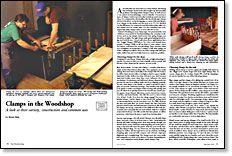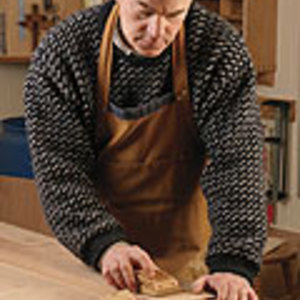All About Clamps

Clamps (or cramps, as the English like to say) come in a variety of sizes and styles. A clamp can be as simple and inexpensive as a heavy rubber band, but most woodworking clamps are constructed largely of metal and can develop hundreds of pounds of pressure.
What Counts:
• Clamp pressure
• Marring or non-marring jaws
• Length
• Depth of throat
• Whether jaws stay parallel under pressure
Bar and pipe clamps are common tools for edge-gluing and furniture and cabinet construction. They have two jaws, one that’s fixed and another that slides along a steel pipe, I-beam or flat bar. Pressure is applied with a hand-crank on the head or with a turned wooden handle on the sliding jaw.
Pipe clamps are economical
Pipe clamps are relatively inexpensive and can be made to virtually any length simply by buying pipe of a different length. They are made to fit either 1/2-in. or 3/4-in. pipe and can hold parts under high pressure. One disadvantage of a pipe clamp is the tendency of the jaws to spring out of parallel slightly as pressure is applied, which can pull furniture out of square and create a bow in glued panels.
A more expensive alternative are parallel-jaw clamps, typically available with capacities from 12 in. to 60 in. Heavy-duty I-beam clamps can develop up to 7,000 lb. of force.
Bar clamps can multitask
Most bar clamps don’t develop as much clamping pressure as pipe clamps or I-beam clamps (several hundred pounds of force would be typical), but they are lighter and less expensive. They come in lengths from 6 in. to 36 in. with a reach (or throat) of 2 in. to 2-1/2 in. Some close with a ratcheting handle and are designed for one-hand use, while others have reversible heads so the clamp can be used to push pieces apart with outward pressure.
No shortage of specialty clamps
In addition to the basic clamps you’ll find in most woodshops, there are many other more specialized clamps to choose from.
C-clamps are rigid C-shaped frames with threaded rod and a small, round clamping pad at one end.
Handscrews consist of two wooden jaws that are opened and closed with a pair of wood handles attached to threaded rod. Because the rods can be adjusted independently, the jaws of these clamps can pivot and conform to angled shapes. Common jaw lengths run from 4 in. to 12 in.
Spring clamps are light-duty and economical. They come with plastic or metal bodies, some with pivoting tips.
Band clamps consist of nylon webbing and a metal ratcheting mechanism. They can go around objects difficult to clamp in any other way, and the nylon webbing won’t mar wood.
Toggle clamps, useful for shop-made jigs, have a rubber-tipped plunger activated by a handle. A number of models are available in a variety of sizes.
Cam clamps develop relatively light clamping pressure, but their wood jaws are non-marring and they are available with more reach than most other types.
Fine Woodworking Recommended Products

Veritas Precision Square

Stanley Powerlock 16-ft. tape measure

Veritas Wheel Marking Gauge























Log in or create an account to post a comment.
Sign up Log in